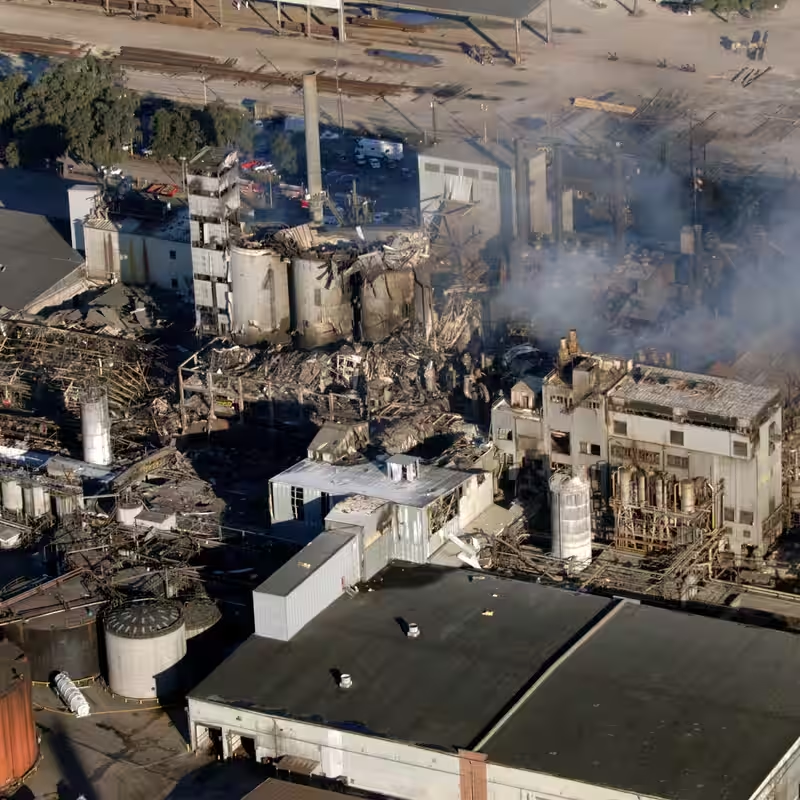Table of Contents
- The Bucksnort Blast That Reignited National Concerns
- Why Do Industrial Plants Keep Exploding?
- 5 of the Deadliest U.S. Factory Explosions Since 1970
- The Hidden Cost of Ignored Warnings
- What Needs to Change to Prevent the Next Disaster?
- Sources
Factory Explosions: A Recurring American Tragedy
The recent explosion at the Accurate Energetic Systems munitions plant in Bucksnort, Tennessee—leaving 19 missing and a half-square-mile of smoldering wreckage—has once again thrust industrial safety into the national spotlight. But this is far from an isolated incident.
From sugar refineries to chemical plants, America’s industrial landscape has been scarred by preventable disasters for decades. What’s chilling is how often these tragedies follow the same script: ignored safety protocols, cost-cutting measures, and a lack of regulatory enforcement.
Why Do Factories Explode?
Industrial explosions typically stem from one or more of the following:
- Combustible dust (e.g., sugar, grain, metal powders)
- Flammable gases or vapors (e.g., propane, natural gas)
- Improper storage of reactive chemicals (e.g., ammonium nitrate)
- Equipment failure or human error
- Lack of ventilation or static control
In munitions facilities like the one in Tennessee, the risk is amplified. Workers handle molten explosives like TNT, RDX, and PETN—substances so sensitive that a spark from a cellphone or static electricity can trigger a chain reaction.
5 of the Deadliest U.S. Factory Explosions Since 1970
| Year | Location | Facility | Deaths | Cause |
|---|---|---|---|---|
| 1971 | Woodbine, GA | Thiokol Chemical Corp. | 29 | Ignition of flare assembly line |
| 1989 | Pasadena, TX | Phillips 66 Houston Chemical Complex | 23 | Gas leak during polyethylene production |
| 2008 | Port Wentworth, GA | Imperial Sugar Refinery | 13 | Sugar dust explosion |
| 2010 | Middletown, CT | Kleen Energy Power Plant | 5 | Gas blowdown procedure ignited |
| 2013 | West, TX | West Fertilizer Company | 15 | Ammonium nitrate detonation (fire likely intentional) |
Each of these disasters led to investigations, lawsuits, and promises of reform—yet the cycle continues.
The Hidden Cost of Ignored Warnings
The 2008 Imperial Sugar explosion is a textbook case of preventable tragedy. OSHA later found that sugar dust had accumulated for years in rafters, conveyor belts, and machinery. Workers had repeatedly raised concerns, but management dismissed them. The result? A $8.7 million fine—the largest in OSHA history at the time—and 13 lives lost.
Similarly, the 2013 West Fertilizer blast occurred despite the company storing 30 tons of ammonium nitrate in wooden bins next to a school—violating federal guidelines. The EPA had not inspected the site in decades.
Even in the Tennessee case, records show Accurate Energetic Systems had at least one OSHA violation in 2019, though details remain sealed. The plant’s work—melting TNT and pouring it into casings—is inherently high-risk, requiring strict protocols that, if breached, can be catastrophic.
What Needs to Change to Prevent the Next Disaster?
Experts agree on several key reforms:
- Mandatory third-party safety audits for high-risk facilities
- Stronger whistleblower protections for workers who report hazards
- Real-time monitoring of combustible dust and gas levels
- Increased OSHA staffing and inspection frequency
- Public disclosure of chemical inventories near residential areas
“These aren’t accidents,” said Dr. Lena Torres, an industrial safety researcher at MIT. “They’re failures of systems that prioritize profit over people.”
As search teams in Bucksnort continue sifting through debris, families cling to hope. But for many Americans living near industrial zones, the fear is ever-present: Could we be next?




